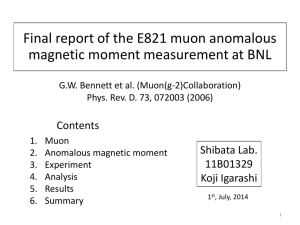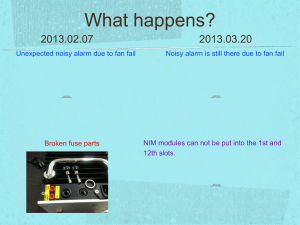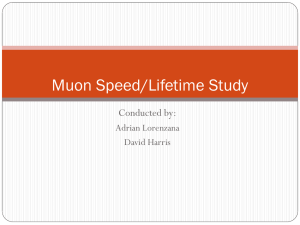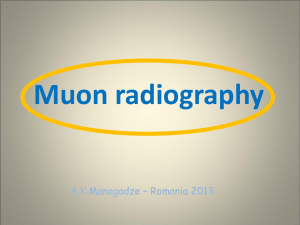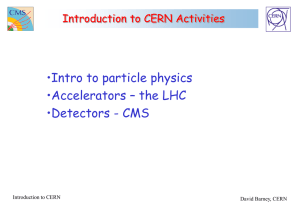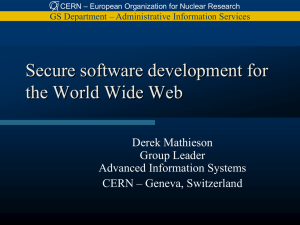Anomalous magnetic moment of the muon
advertisement
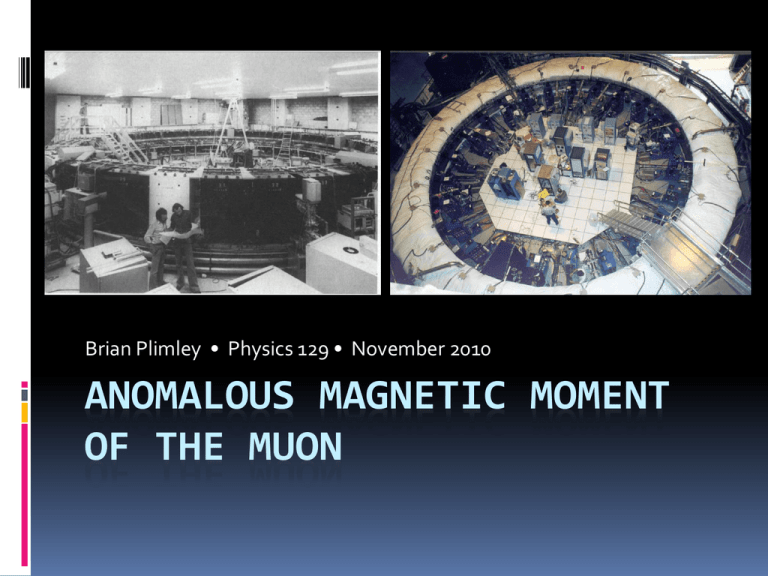
Brian Plimley • Physics 129 • November 2010 ANOMALOUS MAGNETIC MOMENT OF THE MUON Outline What is the anomalous magnetic moment? Why does it matter? Measurements of aµ 1974-1976: CERN 1997-2001: BNL Conclusions What is the anomalous magnetic moment? Magnetic moment: (for a muon) Dirac equation predicts g = 2 for e, µ Quantum vacuum fluctuations adjust this value Anomalous magnetic moment: (for a muon) What is the anomalous magnetic moment? x γ Fundamental diagram: (consistent with aµ = 0) µ Corrections according to Standard Model:γ SM = Standard Model had = hadronic (QCD) EW = electroweak What is the anomalous magnetic moment? x γ Fundamental diagram: (consistent with aµ = 0) µ x γ γ µ µ γ QED electroweak (1st-order corrections) γ γ hadronic Why does it matter? Tests theories of fundamental forces in the Standard Model (QED, weak, QCD) Look for new physics beyond the Standard Model, e.g. supersymmetry (SUSY) Why does it matter? Why muons? Electrons also have an anomalous magnetic moment Electrons are much easier to work with (stable, easy to find) A rare photo of an electron Why does it matter? The amplitude of weak and hadronic diagrams scales with the lepton mass: So the muon magnetic moment is more sensitive to these forces by a factor of (mµ / me)2 ≈ 40 000! (QED has been tested very precisely by ae) Measurements: CERN, 1974-76 This is the third and most advanced measurement of aµ at CERN in the 60s and 70s Measurements: CERN, 1974-76 Protons on a target produce pions, which enter the storage d = 14 m Eµ ≈ 3 GeV (pµ = 3.094 GeV/c) ring and decay into muons (mostly) Muon spins are highly polarized in the forward direction Muons circle the ring many times before decaying into electrons and neutrinos Detectors inside ring detect decay electrons Measurements: CERN, 1974-76 Cyclotron frequency: Spin precession frequency: Measurements: CERN, 1974-76 Spin-cyclotron beat frequency (anomalous precession frequency): Decay electron preferentially emitted along spin axis of muon Measurements: CERN, 1974-76 [figure from BNL work, 2006] Energy threshold selects only electrons emitted along direction of muon momentum Detector countrate oscillates at beat frequency, by which aµ can be calculated… Measurements: CERN, 1974-76 ωL is the Larmor frequency (spin precession of a muon at rest) ωL measured separately Measurements: CERN, 1974-76 CERN results agreed with theory theory (after theorists included certain higher-order Feynman diagrams!) Total experimental uncertainty in aµ: 10 ppm Measurements: BNL, 1997-2001 Same size and energy as CERN, for good reasons Measurements: BNL, 1997-2001 Same technique as CERN experiment, but with improved technology Higher muon fluence Pions decay before entering storage ring, reducing background Superconducting magnets Improved quadrupole focusing Advanced digital electronics et cetera Measurements: BNL, 1997-2001 Same Measurements: BNL, 1997-2001 Calorimeter detectors are a mixture of lead and plastic scintillator Measurements: BNL, 1997-2001 Experimental aµ is 3.4 σ from the most recent Standard Model calculation Conclusions The anomalous magnetic moment of the muon is very useful for testing the fundamental forces of physics Significant discrepancy with theory suggests physics beyond the Standard Model One candidate theory for extension of the Standard model is supersymmetry (SUSY) More work remains to be done to reduce uncertainties in both experimental and theoretical calculations References Content: J. Bailey et al, Nuc. Phys. B150 1 (1979) G.W. Bennett et al, Phys. Rev. D73 072003 (2006) K. Hagiwara et al, Phys. Lett. B649 173-179 (2007) J.M. Paley, PhD dissertation (2004) wikipedia Diagrams: T.G. Steele et al, Phys. Rev. D44 3610-3619 (1991) D.W. Hertzog and W.M. Morse, Annu. Rev. Nucl. Part. Sci. 54 141 174 (2004) Brookhaven g-2 project website University of Glasgow, Particle Physics webpage The Particle Adventure Contemporary Physics Education Project Questions? Some more figures… Some more figures… smuon neutralino sneutrino Some more figures… Some more figures…

